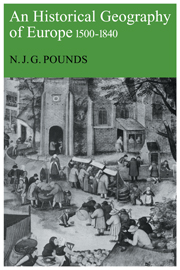Book contents
- Frontmatter
- Contents
- List of maps and diagrams
- List of abbreviations
- Preface
- 1 Europe in the early sixteenth century
- 2 The population of Europe from the sixteenth to the early nineteenth centuries
- 3 The pattern of cities
- 4 Agriculture from the sixteenth to the nineteenth centuries
- 5 Manufacturing and mining
- 6 The pattern of trade
- 7 Europe on the eve of the Industrial Revolution
- Notes
- Index
7 - Europe on the eve of the Industrial Revolution
Published online by Cambridge University Press: 04 August 2010
- Frontmatter
- Contents
- List of maps and diagrams
- List of abbreviations
- Preface
- 1 Europe in the early sixteenth century
- 2 The population of Europe from the sixteenth to the early nineteenth centuries
- 3 The pattern of cities
- 4 Agriculture from the sixteenth to the nineteenth centuries
- 5 Manufacturing and mining
- 6 The pattern of trade
- 7 Europe on the eve of the Industrial Revolution
- Notes
- Index
Summary
In 1815 the old order in Europe was restored insofar as the politicians gathered in Vienna could bring back the institutions and attitudes of a vanished age. The map of Europe was, it is true, modified and simplified. The Austrian Low Countries were merged into a kingdom of the United Netherlands; the number of German states was reduced, and the area of Prussia greatly increased and its power augmented; in Italy, Lombardy and Venezia were incorporated into the empire of the Habsburgs. Poland had disappeared, and Napoleon's Grand Duchy of Warsaw, which had temporarily taken its place, was ruled by the Russian Tsar. In many respects, however, it was a very different Europe from that which had been so rudely shaken by the revolutionary ideas of the French and fought over by the armies of Napoleon. The spirit of nationalism had been intensified, and there was a widespread feeling that government should not only be responsive to public feeling, but should reflect national aspirations.
The previous quarter of a century had been marked by war and civil disturbance in most parts of Europe. A hundred years earlier warfare in Europe had been accompanied by famine crises and epidemics, and the resulting mortality had been heavy. The Revolutionary and Napoleonic Wars had also been accompanied by shortages but there was no famine crisis and no major epidemic. The years immediately following the peace of 1815 were marked by poor harvests and resulting scarcity and high price of food, but there was no abnormal rise in mortality as there had been a century earlier.
- Type
- Chapter
- Information
- An Historical Geography of Europe, 1500-1840 , pp. 307 - 366Publisher: Cambridge University PressPrint publication year: 1980



